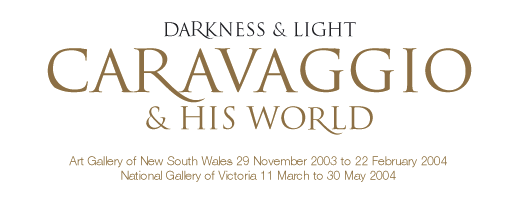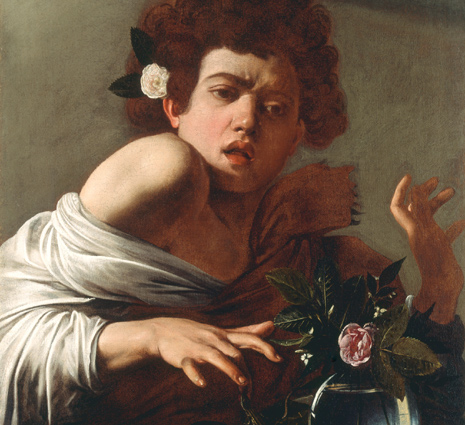

Michelangelo Merisi da Caravaggio (1571-1610) arrived in Rome around 1592 to seek his fortune as a painter. In the 'eternal city' he emerged as the leader of a new artistic era, helping shape the 'baroque', instigating a revolution in style. In 1606 he fled to escape a murder charge and in July 1610 he died whilst returning to Rome in hope of a pardon.
However, Caravaggio's influence has long outlasted his relatively brief presence in Rome. The legacy of his short and violent life is the "...indefinable quality that makes Caravaggio the first artist in history whose paintings seem directly concerned with his own life. Ten years before Shakespeare invented Hamlet, Caravaggio painted Saint Francis in solitary dialogue with a skull. Caravaggio introduced soliloquy into painting at the same time that Shakespeare perfected it in drama..." (John T. Spike, Caravaggio)
The Art Gallery of New South Wales and the National Gallery of Victoria have jointly organised the first exhibition in the Southern Hemisphere to explore the art of Caravaggio, his contemporaries and those who were influenced by his remarkable talent. The directors of these institutions, Edmund Capon and Gerard Vaughan, garnered an international team of Caravaggio experts to contribute both scholarship and assistance in sourcing of international loans for this landmark exhibition.
Caravaggio was a violent man in violent times. The Sack of Rome in 1527 had ushered in a century of extraordinary strife and political intrigue for the populace of Italy -
"In the stillness of San Stefano Rotondo, Sixtus V had wept over the sufferings of the Early Christian Martyrs; but in the prisons of Rome men and women were submitted to identical tortures, and the rack and the veglia, and throughout Rome�more and more victims were hanged, strangled, quartered, beheaded, mutilated, and burned, their numbers increasing as the Jubilee approached." (Helen Langdon, Caravaggio: A Life)
In the late 1590s, Caravaggio's contemporary street-life genre scenes attracted passionate admirers in Rome. Between 1600 and 1606 he was successful in obtaining the most prestigious commissions in Catholic Rome, decorating churches with large-scale religious compositions. His brilliantly staged assemblies of figures confront the viewer - resplendent with blood spurts, grime, dirty fingernails and feet. Caravaggio's world emerged sharp-edged from the shadows, peopled with characters of an unnervingly ordinary humanity.
His unforgettable depictions of card-sharps, fortune-tellers and musicians were widely imitated by artists from regional Italian schools, as well as from France, Spain and the Netherlands. The models for his apostles, saints and other religious figures were plucked from the streets. Caravaggio's effects of darkness split by raking light provided a lesson in dramatic technique that excited artists from Rubens and Rembrandt to the present day.
"Never before had an artist presented religious drama as contemporary life... Nor had any earlier painter dared to break so dramatically with long established studio traditions, painting his figures from nature, directly onto the canvas, with complex effects of studio lighting. It was the figures having been painted from life that most fascinated Caravaggio's contemporaries." (Helen Langdon, Caravaggio: A Life). Drawn from his immediate circle and evoking the life of the Roman streets, the powerful 'presentness' of these models continues to speak most directly and forcefully to the modern world.
The Exhibition
This exhibition features nine paintings that demonstrate the scope and quality of Caravaggio's revolutionary vision including Boy bitten by a lizard (National Gallery, London), St. John the Baptist (Nelson-Atkins Museum of Art, Kansas City) and The Crowning with Thorns (Kunsthistorisches Museum, Vienna).
These works will be augmented with more than fifty paintings by Caravaggio's immediate followers, demonstrating the international nature of his 'school' and its influence. His well-known Italian followers, such as Manfredi, Saraceni and the famous father-daughter pairing of Orazio and Artemisia Gentileschi, are among the exhibition's highlights. Among his non-Italian followers are featured Frenchmen such as Valentin de Boulogne and Georges de la Tour, as well as the Spaniard, de Ribera, and Northern masters, including Ter Brugghen and van Honthorst.
The works in the exhibition illustrate central themes of Caravaggio's world: victims of time and death - decapitation, betrayal, brooding melancholy and silence. Or on a lighter note, victims of gullibility and human folly - sly exponents of the arts of deceit and trickery. Above all, they portray the pleasures and pains of love, sacred and profane. |